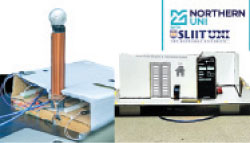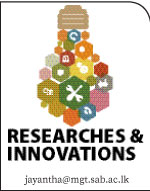
In a groundbreaking step forward for smart home automation, a group of first-year students at the Sri Lanka Institute of Information Technology (SLIIT), Northern Uni, have unveiled an innovative system that fuses Artificial Intelligence (AI), Internet of Things (IoT), and Tesla coil-based wireless power transmission. Their pioneering project, titled SmartSphere, is a robust, intelligent, and energy-efficient smart home ecosystem designed to transform the way we live. This technological feat is not only impressive due to its complexity but also remarkable because of the team’s academic level, freshers from the Faculty of Computing who have pushed the boundaries of what’s possible in undergraduate innovation.
SmartSphere: The Future of Connected Living
 At its core, SmartSphere is a fully integrated AI-powered smart home system. It handles everything from multi-factor biometric access to weather-responsive environmental controls, and most notably, wireless energy delivery through Tesla coil technology. This eliminates the traditional reliance on physical wiring, paving the way for a safer, neater, and more adaptable living environment. The SmartSphere project has already demonstrated significant performance metrics when compared to conventional systems:
At its core, SmartSphere is a fully integrated AI-powered smart home system. It handles everything from multi-factor biometric access to weather-responsive environmental controls, and most notably, wireless energy delivery through Tesla coil technology. This eliminates the traditional reliance on physical wiring, paving the way for a safer, neater, and more adaptable living environment. The SmartSphere project has already demonstrated significant performance metrics when compared to conventional systems:
 Energy Efficiency increased by 14 percent (from 68 percent to 82 percent ), System Response Time improved by 75 percent , with sub-second operation. Wiring Requirements slashed by 86 percent , reducing clutter and installation time. Device Compatibility rose to 92 percent , ensuring broad ecosystem integration.
Energy Efficiency increased by 14 percent (from 68 percent to 82 percent ), System Response Time improved by 75 percent , with sub-second operation. Wiring Requirements slashed by 86 percent , reducing clutter and installation time. Device Compatibility rose to 92 percent , ensuring broad ecosystem integration.
Core Technologies Behind SmartSphere
SmartSphere’s cutting-edge functionality stems from a careful integration of multiple advanced technologies:
AI and Computer Vision: Using OpenCV and TensorFlow, the system detects anomalies (e.g., suspicious motion or sound), performs facial emotion recognition, and adapts the environment accordingly, such as changing lighting or playing music to match a user’s mood.
Multi-Factor Authentication: A biometric security system utilising fingerprint scanning, facial recognition, and IR sensors ensures secure home access with minimal false activations (75 percent reduction).
Tesla Coil-Based Wireless Power Transmission: Inspired by Nikola Tesla’s historic experiments, this technology enables the wireless powering of smart home devices. The system demonstrated an effective range of up to 5 meters with a power transmission efficiency of 75–85 percent .
Edge AI Processing: Devices like ESP32 and Arduino Mega 2560 handle real-time tasks locally, reducing reliance on cloud servers and improving speed and privacy.
Sustainability at its Heart
Beyond its intelligence, SmartSphere is designed with sustainability in mind. The architecture is engineered to integrate with renewable energy sources, such as solar panels. By optimising device operation based on real-time occupancy and environmental data, it significantly reduces energy waste. A built-in current sensor allows users to monitor and manage their energy consumption effectively.
The wireless power system also significantly reduces the need for batteries in IoT devices, minimising long-term maintenance and aligning with global sustainability goals.
Safety and Security Re-imagined
Security is a significant component of any home automation solution. In SmartSphere, security is addressed both physically and digitally:
Physical Security: Through voice commands, PIN code entry, fingerprint scanning, and IR tracking, the system ensures that only authorised individuals can gain access.
Digital Security: All biometric and sensor data are encrypted using AES-256 standards, and the system operates within FCC-compliant electromagnetic emission limits for safety.
The AI-enabled Acoustic Anomaly Detection (AAD) module can even detect critical sounds, such as glass breaking or gas leaks, and send immediate alerts to homeowners.
Wireless Power: From Concept to Reality
One of the most impressive features of SmartSphere is its Tesla coil wireless power module. The system includes: A Tesla Coil Transmitter, operating at 15 MHz and powered by a 12–24V source, A Receiver Coil that charges smart devices wirelessly, An operational range of 3–5 meters with built-in thermal safety cutoffs (80°C for transmitter, 70°C for receiver)
In testing, even an LED-powered device lit up wirelessly, indicating successful power transfer. This technology offers massive potential for placing sensors and devices in areas that were once inaccessible, such as outdoors, high ceilings, or embedded walls.
A Personalised and Intelligent Living Experience
Another area where SmartSphere shines is user personalisation. The system adjusts to environmental and emotional cues, detecting the user’s mood and tailoring room lighting, sound, and even fragrance distribution (via IoT-based dispensers) to enhance comfort.
For instance, if the AI detects a user returning home after a rainy day, it can warm the environment, turn on soft lighting, and play soothing music. This level of responsiveness is made possible by the synergy between AI, IoT sensors, and advanced rule-based engines.
Simplified Deployment and Real-World Readiness
One of the most significant challenges to the adoption of smart homes is the complexity of the installation process. SmartSphere addresses this head-on. With wireless energy transmission, wiring is drastically minimised. This makes deployment faster (installation time was reduced from 24 to 8 hours) and allows devices to be freely positioned.
The modular, plug-and-play architecture supports Zigbee, Z-Wave, and WiFi protocols, allowing homeowners to expand their systems as needed without significant rework.
Education Driving Innovation
This entire project is a direct result of SLIIT Northern Uni’s dedication to hands-on, research-oriented education. Guided by faculty members from both SLIIT Malabe and SLIIT Northern Uni, a group of first-year, first-semester students, K. Abishakan, Kanifer S.K., N. Gowshika, Mithunalini R., M. Rajin, U. Ayushyaa, and Jerun Kingston, not only conceptualised but also successfully implemented a solution that stands on par with industrial-grade smart home platforms.
“This is not just a student project; it is a compelling proof of concept for the future of smart living. The newly developed academic curriculum at SLIIT demonstrates how empowering young minds with the right blend of freedom, tools, and expert mentorship can foster transformative innovation. By embracing trending, technology-driven education, SLIIT is not only enhancing student knowledge and practical skills but also contributing to the broader vision of national development. Initiatives like these reflect the potential of a forward-thinking education system to shape the next generation of tech leaders and problem-solvers.”
Looking Ahead
The SmartSphere team is now working on enhancing the system’s wireless range, reducing electromagnetic interference, and integrating AI-driven learning that adapts to long-term user behaviour patterns. Future upgrades will also focus on improving long-distance wireless energy efficiency and refining safety mechanisms. With this project, the students of SLIIT Northern Uni have demonstrated how innovation rooted in academic curiosity can lead to real-world solutions that are scalable, sustainable, and secure.
Conclusion
SmartSphere is more than an academic project; it is a vision of the smart homes of tomorrow. By integrating AI, IoT, and wireless energy from Tesla coils into a unified platform, the system represents a significant leap forward in intelligent, efficient, and secure living.
As Sri Lanka and the world move toward more innovative urban infrastructure and sustainable living, projects like SmartSphere set a powerful precedent, showing that even first-year university students can lead the charge in the global smart tech revolution.
This project reflects what education should truly aim for: empowering young minds to solve real-world problems through creativity and collaboration.
Dr. Sanvitha Kasthuriarachchi.
Head – First Year Division
Assistant Professor, Faculty of Computing,
Sri Lanka Institute of Information Technology (SLIIT), Malabe, Sri Lanka.
Jerun Kingston Jurison Jenaraj, Student,
Faculty of Computing,
Sri Lanka Institute of Information Technology (SLIIT) Northern Uni, Jaffna, Sri Lanka.
Ayushyaa Umasuthan, Student,
Faculty of Computing,
Sri Lanka Institute of Information Technology (SLIIT) Northern Uni, Jaffna, Sri Lanka.
Vigneswaran Vithiyasahar, Academic Instructor,
Faculty of Computing,
Sri Lanka Institute of Information Technology (SLIIT) Northern Uni, Jaffna, Sri Lanka.
Kanagasabai Thiruthanigesan, Lecturer,
Faculty of Computing,
Sri Lanka Institute of Information Technology (SLIIT) Northern Uni, Jaffna, Sri Lanka.








